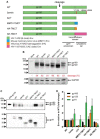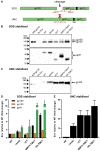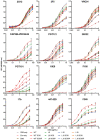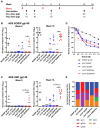Immunogenicity of HIV-1-Based Virus-Like Particles with Increased Incorporation and Stability of Membrane-Bound Env
- PMID: 33801906
- PMCID: PMC8002006
- DOI: 10.3390/vaccines9030239
Immunogenicity of HIV-1-Based Virus-Like Particles with Increased Incorporation and Stability of Membrane-Bound Env
Abstract
An optimal prophylactic vaccine to prevent human immunodeficiency virus (HIV-1) transmission should elicit protective antibody responses against the HIV-1 envelope glycoprotein (Env). Replication-incompetent HIV-1 virus-like particles (VLPs) offer the opportunity to present virion-associated Env with a native-like structure during vaccination that closely resembles that encountered on infectious virus. Here, we optimized the incorporation of Env into previously designed mature-form VLPs (mVLPs) and assessed their immunogenicity in mice. The incorporation of Env into mVLPs was increased by replacing the Env transmembrane and cytoplasmic tail domains with those of influenza haemagglutinin (HA-TMCT). Furthermore, Env was stabilized on the VLP surface by introducing an interchain disulfide and proline substitution (SOSIP) mutations typically employed to stabilize soluble Env trimers. The resulting mVLPs efficiently presented neutralizing antibody epitopes while minimizing exposure of non-neutralizing antibody sites. Vaccination of mice with mVLPs elicited a broader range of Env-specific antibody isotypes than Env presented on immature VLPs or extracellular vesicles. The mVLPs bearing HA-TMCT-modified Env consistently induced anti-Env antibody responses that mediated modest neutralization activity. These mVLPs are potentially useful immunogens for eliciting neutralizing antibody responses that target native Env epitopes on infectious HIV-1 virions.
Keywords: Env incorporation; HIV-1; SOSIP; VLP; mature form; virus-like particle.
Conflict of interest statement
The authors declare no conflict of interest. The funders had no role in the design of the study; in the collection, analyses, or interpretation of data; in the writing of the manuscript; or in the decision to publish the results.
Figures







Similar articles
-
HIV-1-based Virus-like Particles that Morphologically Resemble Mature, Infectious HIV-1 Virions.Viruses. 2019 Jun 2;11(6):507. doi: 10.3390/v11060507. Viruses. 2019. PMID: 31159488 Free PMC article.
-
Production and Immunogenicity of FeLV Gag-Based VLPs Exposing a Stabilized FeLV Envelope Glycoprotein.Viruses. 2024 Jun 19;16(6):987. doi: 10.3390/v16060987. Viruses. 2024. PMID: 38932278 Free PMC article.
-
Comparison of Uncleaved and Mature Human Immunodeficiency Virus Membrane Envelope Glycoprotein Trimers.J Virol. 2018 May 29;92(12):e00277-18. doi: 10.1128/JVI.00277-18. Print 2018 Jun 15. J Virol. 2018. PMID: 29618643 Free PMC article.
-
Potent Induction of Envelope-Specific Antibody Responses by Virus-Like Particle Immunogens Based on HIV-1 Envelopes from Patients with Early Broadly Neutralizing Responses.J Virol. 2022 Jan 12;96(1):e0134321. doi: 10.1128/JVI.01343-21. Epub 2021 Oct 20. J Virol. 2022. PMID: 34668778 Free PMC article.
-
[VLP vaccines and effects of HIV-1 Env protein modifications on their antigenic properties].Mol Biol (Mosk). 2016 May-Jun;50(3):406-15. doi: 10.7868/S0026898416030113. Mol Biol (Mosk). 2016. PMID: 27414779 Review. Russian.
Cited by
-
A Hydrodynamic Approach to the Study of HIV Virus-Like Particle (VLP) Tangential Flow Filtration.Membranes (Basel). 2022 Dec 9;12(12):1248. doi: 10.3390/membranes12121248. Membranes (Basel). 2022. PMID: 36557156 Free PMC article.
-
An engineered HIV-1 Gag-based VLP displaying high antigen density induces strong antibody-dependent functional immune responses.NPJ Vaccines. 2023 Apr 6;8(1):51. doi: 10.1038/s41541-023-00648-4. NPJ Vaccines. 2023. PMID: 37024469 Free PMC article.
-
Decorated and Encapsulated: Virus-Like Particles Against Viral Infections.Vaccines (Basel). 2021 Mar 18;9(3):273. doi: 10.3390/vaccines9030273. Vaccines (Basel). 2021. PMID: 33803636 Free PMC article.
-
Characterization and application of recombinant Bovine Leukemia Virus Env protein.Sci Rep. 2024 May 28;14(1):12190. doi: 10.1038/s41598-024-62811-8. Sci Rep. 2024. PMID: 38806566 Free PMC article.
-
Characterization of the Human Immunodeficiency Virus (HIV-1) Envelope Glycoprotein Conformational States on Infectious Virus Particles.J Virol. 2023 Mar 30;97(3):e0185722. doi: 10.1128/jvi.01857-22. Epub 2023 Feb 23. J Virol. 2023. PMID: 36815832 Free PMC article.
References
LinkOut - more resources
Full Text Sources
Other Literature Sources

